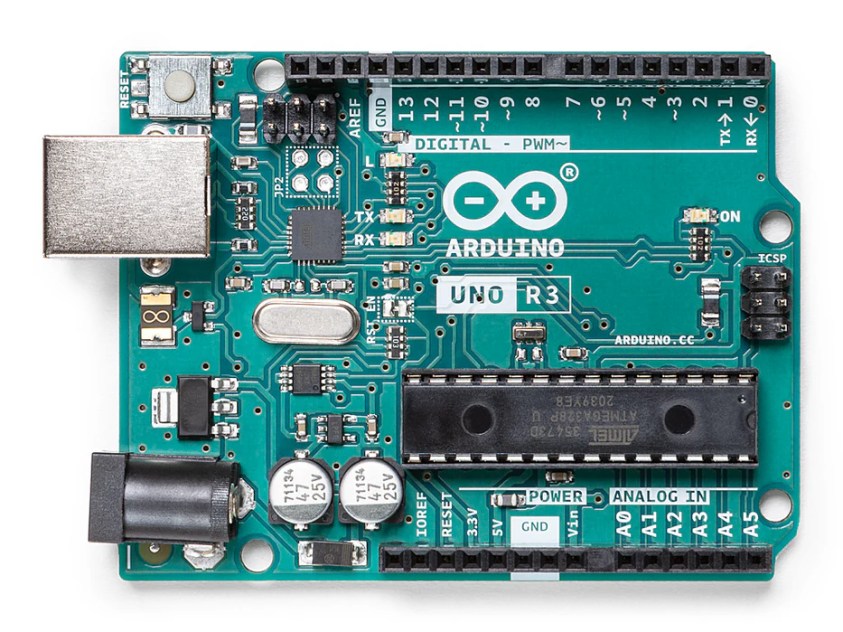
What is an Arduino?
Arduino is an open-source electronics platform based on easy-to-use hardware and software. The platform is designed to make the process of using electronics in multidisciplinary projects more accessible. It consists of a microcontroller. This microcontroller is a small computer on a single integrated circuit. It contains a processor core, memory, and programmable input/output peripherals.
Key Components
- Microcontroller: The board’s core component is a microcontroller. It runs the code and processes inputs to control outputs.
- Digital and Analog Pins: These pins are used to interface with various sensors and actuators. Digital pins are used for binary input/output (on/off), while analog pins can read varying signals.
- USB Interface: This is used for programming the microcontroller and for communication between the Arduino and a computer.
- Power Supply: Arduinos can be powered via USB or an external power supply.
- IDE (Integrated Development Environment): The Arduino IDE is the software used to write and upload programs to the Arduino board. It supports a simplified version of C++.
Popular Arduino Boards
- Uno: The most commonly used board, suitable for beginners and basic projects.
- Nano: A smaller, breadboard-friendly version of the Uno.
- Mega: Offers more pins and memory, suitable for more complex projects.
- Leonardo: Features a built-in USB communication capability.
Uses of Arduino in an Aquarium
Aquariums require constant monitoring and control to maintain a healthy environment for aquatic life. Arduino can be used to automate and manage various aspects of an aquarium, improving efficiency and reducing manual intervention.
Common Applications
- Temperature Control:
- Sensors: Digital temperature sensors like the DS18B20 can monitor water temperature.
- Actuators: Relays connected to heaters or fans can be triggered to maintain optimal temperature ranges.
- Lighting Control:
- Timers: Programmable timers can control LED lights to simulate natural daylight cycles.
- Dimming: Pulse Width Modulation (PWM) can be used to adjust light intensity smoothly.
- Water Quality Monitoring:
- pH Sensors: Continuous monitoring of pH levels to ensure water quality.
- TDS Sensors: Total Dissolved Solids (TDS) sensors measure the concentration of dissolved substances.
- Feeding Systems:
- Automatic Feeders: Stepper motors or servo motors can be used to automate fish feeding schedules.
- Custom Schedules: Feeding times and quantities can be customized via the Arduino.
- Water Level Control:
- Float Switches: Detect changes in water level and trigger pumps to add or remove water.
- Sump Pumps: Used to automate water changes and maintain stable water levels.
- Circulation and Filtration:
- Pump Control: Timers and relays can manage the operation of water pumps and filtration systems.
- Wave Makers: DC motors controlled by the Arduino can create currents and waves.
- Algae Control:
- UV Sterilizers: Controlled via relays to reduce algae growth.
- Algae Scrubbers: Timed lighting cycles help promote algae growth on scrubbers. You can clean them later to remove excess nutrients.
Advantages of Using Arduino in Aquariums
- Cost-Effective: Arduino boards and components are relatively inexpensive.
- Customizable: The open-source nature allows for highly customizable solutions tailored to specific needs.
- Expandable: Additional sensors and actuators can be easily integrated as requirements evolve.
- Community Support: A large online community provides resources, tutorials, and support.
Challenges and Considerations
- Waterproofing: Ensure all electronic components are properly sealed and protected from water exposure.
- Power Management: Consider backup power solutions to maintain operation during power outages.
- Maintenance: Regular maintenance and calibration are essential to ensure long-term reliability.
- Skill Level: Basic knowledge of electronics and programming is required to set up and maintain the system.
Using Arduino in an aquarium setup offers a versatile way to automate various environmental parameters. It also provides an efficient method to monitor these conditions. This automation contributes to a healthier and more stable aquatic ecosystem. By leveraging the capabilities of Arduino, aquarists can reduce manual tasks. They can enhance precision and create a more sustainable environment for their aquatic inhabitants.

